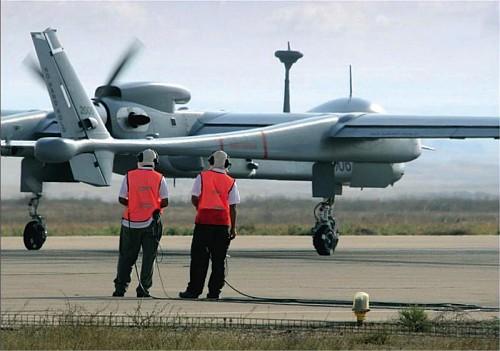Israel unveils world's largest UAV
The Eitan is 79 feet long, has a wingspan of 86 feet — about the size of a Boeing 737 airliner — and can stay aloft for 20 hours at high altitude; powered by a 1,200-horsepower turbojet engine, it has a maximum altitude of 40,000 feet and can carry hundreds of pounds of equipment, such as high-resolution cameras and electronic systems and presumably weapons; Israel says the UAV has the capability of reaching the Gulf

The Eitan // Source: aviationnews.eu
Israel Aerospace Industries (IAI) has unveiled a long-range UAV is yet another signal of the country’s preparation for a military strike against Iran’s nuclear capabilities. The UAV is a big technological breakthrough for a defense industry that has carved a niche for itself in the global arms market.
UPI reports that the 4.5-ton Heron TP, dubbed the Eitan (Hebrew for “strong”), is 79 feet long. It has a wingspan of 86 feet — about the size of a Boeing 737 airliner — and stay aloft for 20 hours at high altitude, a capability Israeli UAVs have hitherto lacked.
Powered by a 1,200-horsepower turbojet engine, it has a maximum altitude of 40,000 feet and can carry hundreds of pounds of equipment, such as high-resolution cameras and electronic systems and presumably weapons.
The aircraft, the largest UAV in operational service anywhere in the world, made its debut Sunday at the Israeli air force’s big Tel Nof base in central Israel where UAV squadrons operate the Samson and Delilah craft. The air force declines to specify what missions the Eitan will fly, or whether it was designed for use against Iran.
The state-owned IAI, the flagship of Israel’s defense industry, says it has the capability of reaching the Gulf. Defense officials said the Eitan could be used for a variety of missions, such as surveillance and electronic jamming.
NextBigFuture notes that with maximum takeoff weight of 4650 kg, the 14 meter long aircraft can carry over 1,000 kg of sensors in its forward section, main payload bay, and the two bulges located at the end of each tail boom, offering optimal separation for specific systems. For comparison, a B52 can carry about 70,000 pounds (33,000 kg) worth of bombs and a B1 bomber about 40,000 pounds. So it would take 35 Eitan UAVs to equal the bomb load of a B52.
Retired Gen. Shlomo Bron, now a security specialist with the Institute for National Security Studies at Tel Aviv University, hails the Eitan as a breakthrough. “Its staying power and the altitude it can reach means it is able to cover ground continuously and is able to cover large territory,” he said.
Israel’s defense industry has emerged as a world leader in UAV technology and exports the systems to a dozen countries, including the United States which has deployed them in Afghanistan and Iraq.
UPI notes that five of the NATO members
